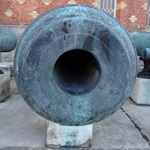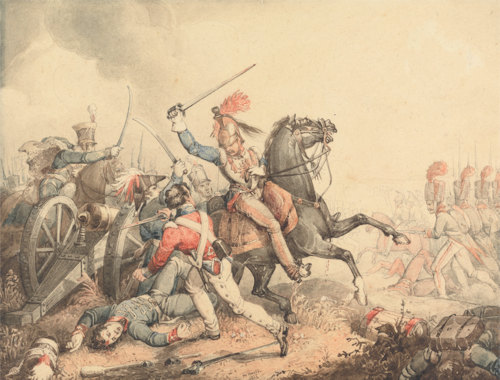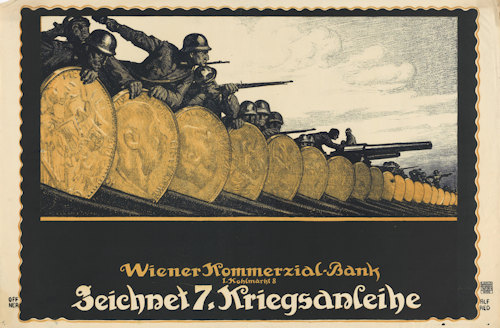
Vienna’s Heeresgeschichtliches Museum (Museum of Military History) features some breathtaking items from the past. These include one exhibit that drew a very bad swearword from me when I saw it.
- Numerous objects that witnessed or changed world history
- Weapons, clothes, and medals from historical personalities
- Poignant WWI display
- Book a guided WWII/Holocaust tour* of Vienna
- See also:
The museum has a new director, so the permanent exhibitions may undergo some change as the institution modifies its displays in light of contemporary needs.
I will update this post accordingly as I learn of developments, but be prepared for some deviations from the below.
At the time of writing, for example, expect these parts to be closed temporarily:
- The exhibition area covering 1918-1945 (undergoing reorganisation)
- The galleries addressing the 16th, 17th and most of the 18th century (undergoing renovation)
A car and a coat

(The car of the heir to the throne, Franz Ferdinand, with bullet holes; photo taken in 1914; collection of the Wien Museum; reproduced with permission under the terms of the CC0 licence)
Various items in the museum’s displays come from critical moments in Austrian, European and even world history.
You probably know, for example, that the 1914 assassination of Franz Ferdinand in Sarajevo led to the first World War. He was in a car at the time and wearing his uniform.
The museum has the car. (This is where I swore.)
And the uniform…still bloodstained. (Cue further swearing.)
In terms of world history, that’s a tough act to follow, but at least one other exhibit comes close: the Russian officer’s coat worn by Napoleon in 1814 on his way to exile on the Island of Elba.
And the rest…
I’m going to follow the layout of the main museum galleries and mention my highlights in each. Beginning with…
The 30 years war & Ottoman squabbles

(Turkish sabre, 1650–1700, Wien Museum Inv.-Nr. 126245, excerpt reproduced under the terms of the CC BY 4.0 license; photo by Birgit und Peter Kainz, Wien Museum)
The early galleries reflect times when war largely involved hand-to-hand combat driven by visceral fear. Never a great feeling when confronted by rows of sharp pikes and people trying to stick the pointy ends into you.
The very first gallery has a cabinet of Ottoman weapons. The markedly different designs when compared to their Habsburg equivalents illustrate the clash of cultures involved in the conflicts between the two empires.
The reverse side of the cabinet features a giant painting of the relief of the siege of Vienna in 1683, a pivotal moment in European history.
In the painting, the besieging Ottomans are all wild-eyed, while the “liberators” almost look like they’re clearing leaves before a picnic. No guesses as to which side the painter was on. Media manipulation is nothing new: just the media changes.
The same gallery confronts us with our first iconic items connected to a historical personality: Prince Eugene of Savoy (1663 – 1736) was perhaps the greatest military commander of the Habsburg era.
We see Eugene’s breastplate, for example, and the seal of Sultan Mustafa II, captured by Eugene at the 1697 battle of Zenta that effectively ended Ottoman hegemony in central Europe.
(Learn more about Eugene on a visit to his Viennese palace home at Belvedere, also home to prestigious art collections and exhibitions.)
18th century: Balkan & Prussian wars
The so-called Mortar of Belgrade is a 10lb mortar used by Prince Eugene at Belgrade in 1717.
Things seemed set for a long siege of the Ottoman stronghold when a shell from this very mortar hit the powder supplies. The explosion ripped its way across the city killing around 3,000 men.
Another display case carries the spoils of war: hats, swords, flags, pikes and more taken from Prussian foes and similar. You can imagine each has a story to tell.
One side’s glory is another’s failure. You can’t help but wonder what happened to the soldiers who lost their helmets to the Austrians.
Napoleonic wars & 1848 revolution

(An Episode at the Battle of Waterloo by the artist William Heath, 1817; image courtesy of the Yale Center for British Art)
This gallery is full of exhibits bringing Austrian history to life.
Visit the typical tourist sights in Vienna, for example, and you soon learn of the importance of Napoleon to the city’s past.
In among the French paraphernalia and memorabilia of the time (including the aforementioned coat) are, for example, the medals worn by the ruling Habsburg Emperor (Franz II/I), the Russian Emperor (Alexander I), and the Prussian Emperor (Friedrich Wilhelm III).
One wall has a famous portrait of Franz II/I in his coronation robes, as painted by Leopold Kupelwieser. The cabinet alongside has the medallion you see in the painting.
Oh, and the innocent-looking hot air balloon hanging from another wall is actually a French war balloon and possibly the first aerial military vehicle in all of history.
Radetzky & the mid-19th century
Field Marshal Radetzky (1766 – 1858) was almost up there with Prince Eugene as the most iconic of the Habsburg’s generals. You can tell from the dozens of medals he had.
They revered the poor fellow so much they didn’t let him retire until he was 90. And he has a large equestrian statue on today’s Stubenring.
In this gallery we start to see the shift from veneration of personalities and glorification of war to a more realistic perspective of the travails of the simple soldier.
Nowhere is this clearer than in the end wall painting by Václav Sochor of the 1866 Battle of Königgrätz, when the Prussians scored the decisive victory of the Austro-Prussian war.
The Battery of the Dead pictures the bloody, desperate (brave) final moments of the horse-drawn artillery battery that covered the Austrian retreat.
Franz Joseph through to Sarajevo

(Kaiser Franz Joseph I. and the loyal generals Welden, Radetzky, D’Aspre, Schlik, Wohlgemuth, Heinau and Jelačić, 1849; lithography by Karl Lanzedelli; Wien Museum Inv.-Nr. 87547, reproduced with permission under the terms of the CC0 licence)
This is perhaps the last of the galleries to focus on any individuals, with, for example, various memorabilia from the life of Emperor Franz Joseph. This includes his sword and the same gala uniform famous from pictures and paintings of the Emperor.
I also enjoyed the books containing the soldier’s oath: the same book in 11 versions, one for each of the major languages spoken in the Austro-Hungarian Empire.
And then there’s that car. It sits at the end of the gallery, right at the entrance to the WWI section.
WWI
The whole of this gallery offers a startling contrast to all that precedes it.
The displays take you through the chronology of the conflict, illustrating the impacts of scale, mechanisation and dehumanisation on the outcome of war. No glorification and veneration here.
The split-level displays, hundreds of original items, a simulated trench, and more leave a lasting impression.
Those of us who grew up in northern Europe tend to associate WWI with trench warfare in France. For Austria, it was much more than that: mountain warfare against the Italians, for example, or pushing for a land bridge to their Ottoman allies. It’s all quite an eye-opener.
The gallery has everything from an Albatros biplane to a 38cm howitzer. Highlights for me were the set of medals given for increasing numbers of injuries: 1, 2, 3, 4 and 5(!). Unimaginable.
And we discover another moving painting: the war painter Albin Egger Lienz’s The Nameless 1914, a dark, depressing expressionist illustration of the subsuming of individual identity in a killing corps.

(1917 war bonds issued by the Wiener Kommerzial Bank; art by Alfred Offner; Wien Museum Inv.-Nr. 42313/2; excerpt reproduced with permission under the terms of the CC0 licence)
WWI to the end of WWII
Nothing really compares to the displayed horrors of WWI, but the cruel banality of the various Nazi memorabilia comes close, reminding me of similar exhibits in the House of Austrian History.
The ubiquity of Nazi symbolism and propaganda on even the most innocent of items is, frankly, chilling.
Perhaps the most iconic exhibit here is the US military jeep famous for carrying four military police in central Vienna (one each from the UK, the US, Russia and France) after allied forces occupied the city. You might know it from the opening sequences of the film, The Third Man.
Austrian naval power
And, finally, the gallery for the Austrian navy.
That’s not an oxymoron; the Habsburg empire extended down to the coast at Triest, for example. The gallery features numerous model ships, often very large, particularly the incredibly-detailed cutaway model of one of the last dreadnoughts. And there’s the conning tower of a submarine here, too.
I’ve only scratched the surface of the hundreds of exhibits at the Heeresgeschichtliches Museum, not to mention the artillery halls or outside tank displays (that I missed). Anyone with an interest in history or military history will find the galleries a rewarding experience.